The first cold nights of the year usually come unexpectedly. Then it can happen that plants are affected by frost damage. However, this can often be avoided and does not immediately mean the death of the plants.

Winter is a tough time for many animals and plants. So there is often frost damage to cherry laurel (Prunus laurocerasus), olive trees (Olea europaea) and other garden plants. In this article you will learn how to recognize this frost damage, what to do when plants have received too much frost and how to avoid frost damage.
contents
- How does frost damage occur on plants?
- Identify frost damage to plants
- Can you revive frozen plants?
- Avoid frost damage to plants
How does frost damage occur on plants?
Frost damage to plants can occur for two different reasons:
- If the plant does not have a strategy for enduring the cold: This is often the case with subtropical and tropical plants. If you want to know what exactly plants in winter and how they survive cold temperatures, you can read more about in our special article.
- If the plant has not been given a chance to adjust to frost: This often happens when planted straight from the greenhouse or apartment into the garden. The plants are then not prepared for the new situation and suffer frost damage. Incorrect care also reduces the frost hardness.

Cold temperatures damage plants in several ways:
Freezing water in the cells: Below 0 °C, the water in the cells begins to freeze. The ice crystals that form can cause lasting damage to structures within the plant cell and kill unadapted plants within hours. However, plants from temperate latitudes can prevent the water from freezing. This ability is available to them through evolutionary adaptation. Subtropical and tropical plants do not have this ability or only to a limited extent. But even hardy plants that grow in tubs can fall victim to the complete freezing of the root ball. Because naturally their roots would be a little more protected and isolated in the grown soil.

Cold affects cell membranes and metabolic processes: Cell membranes are made of lipids, i.e. fats. When it gets cold, these lipid membranes become less flexible and the exchange of substances that takes place across the membranes can be less well controlled. In addition, biochemical processes run more slowly in the cold. It can happen that vital processes in the plant run too slowly or even come to a complete standstill.
Frost drought of evergreens: Another frost damage to plants that particularly affects evergreen plants such as rhododendrons (rhododendron spec.) or Ilex (ilex spec.) is affected by frost drought. This may seem illogical at first, because there is usually no lack of snow and rain in winter. But if the cold persists, it can happen that not enough water can be supplied from the frozen ground to compensate for the loss of the above-ground, green plant organs. Even without ground frost, roots in cold soil are much less effective. This becomes particularly problematic when the winter sun is shining.
Tip: If rhododendrons let their leaves droop in winter, this is due to the cold-related lack of water - the frost drought. However, there is usually no acute need for action. As a precaution, however, you should always plant evergreens in shady locations and isolate their root area with a layer of mulch.
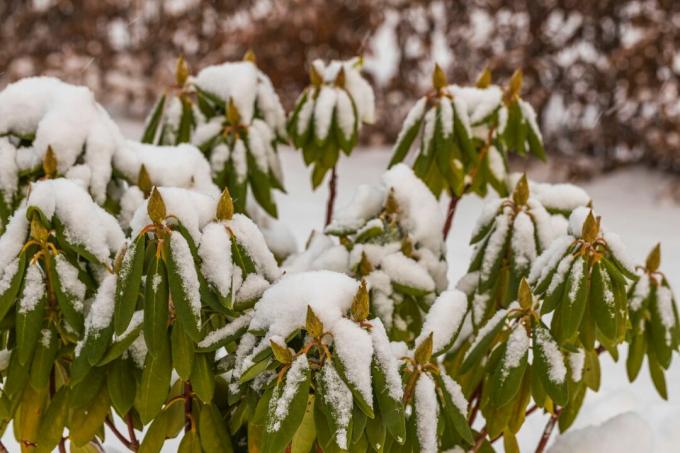
Stress cracks due to temperature fluctuations: Especially with young trees, it can also happen that the bark tears. This is due to the fact that the large temperature differences between day and night or between the sunny and shady sides of the tree, the still thin bark tissue expands or contracts at different speeds, leading to tension and finally cracks can. A coat of lime offers protection against this.
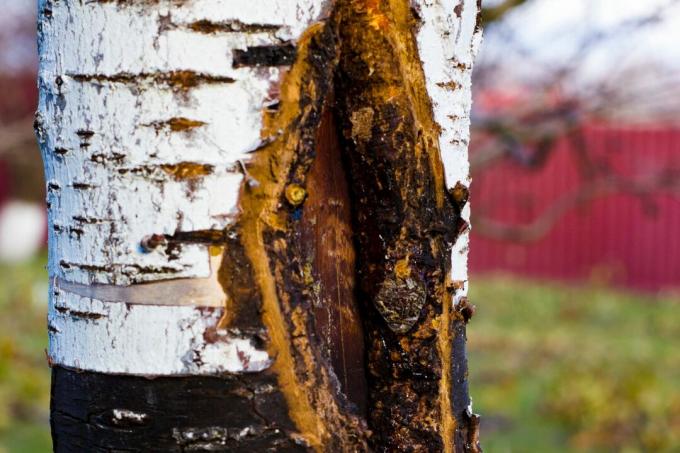
Late frost damage to flowers and new shoots: In the course of climate change, mild and short winters are becoming more frequent. This gives the overwintering plants the starting signal for budding and flowering early in the year. These blossoms and shoots, which appeared too early, are often damaged by late frosts. The fruit tree blossom in particular is often affected.
Identify frost damage to plants
How to recognize frost damage to plants depends on the part of the plant that is affected and the type of frost damage. However, common signs of frost damage to plants include:
- leaves: First the tips of the leaves turn brown and dry up, later the whole leaf; curled leaves can indicate drought stress.
- Herbaceous plant parts: Become mushy, turn brown and rot after exposure to frost.
- Woody plant parts: Appears dry, brown and wrinkled; cracks in the bark.
- buds and flowers: Dry up, turn brown and fall off.

Some plants are more frequently affected by frost damage, olive trees and cherry laurel hedges, for example. Brown leaves can be a sign of frost damage to cherry laurel. Other possible causes of brown and yellow leaves on cherry laurel can be found in a separate article.
also on hemp palms (Trachycarpus fortunei) usually draw attention to frost damage with brown leaves.
Thanks to the hot summers, more and more people are daring to plant their own olive trees. Olive trees can be damaged by frost if they are not brought indoors early enough. As with frost damage to cherry laurel and hemp palm, the leaves of the olive tree, which often fall off after frost, are the first to be affected. If the frost was not too severe and you brought the tree indoors in good time, it should sprout again next spring.
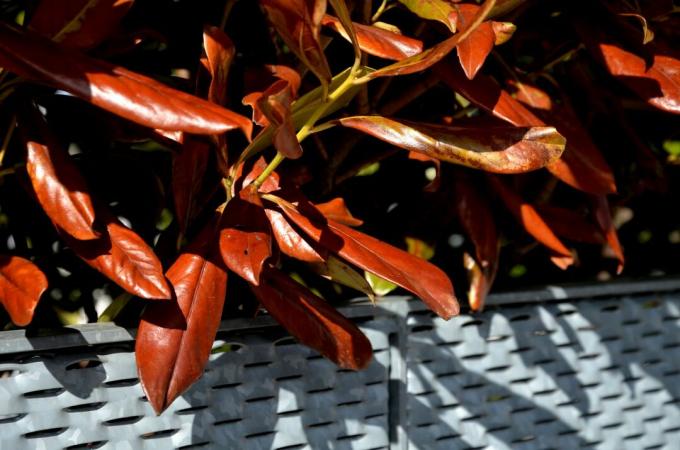
Indoor plants can also suffer frost damage. This usually happens faster than you think. Indoor plants usually have a relatively high temperature optimum. It can happen that cold stress occurs in the plants at well over 0 °C. For example, if you put the indoor plant on the balcony on a nice summer day and the temperature falls below 10 °C at night, it can already mean its death.
Can you revive frozen plants?
What can you do if plants are damaged by frost? Or are the affected plants automatically dead?
If a plant is actually frozen, it can no longer be revived. It is often the case, however, that plants appear dead and lifeless, but sprout again the next spring. So be patient and wait. If there is still no shoot visible at the end of May, the whole plant has probably been affected.
Tip: If you are not sure whether your plant has received frost damage, you can do the scratch test. Simply scrape off a piece of bark. If the green, lively cambium appears underneath, this part of the plant has survived the winter well.

If you spot signs of frost damage on your plant, take protective measures. See the next section for some tips.
Don't worry if, for example, your cherry laurel has frost damage and some leaves are brown. In most cases, the wood will sprout again. It is therefore sufficient if you cut off the unsightly, brown leaves of the cherry laurel after frost damage. However, the best time to do this is not directly when you notice the damage, still in winter, but in the following spring. This generally applies to pruning measures that are carried out as a result of frost damage. In the spring, after the new shoots, you can see better which areas are affected by frost damage and only cut away what has really died.
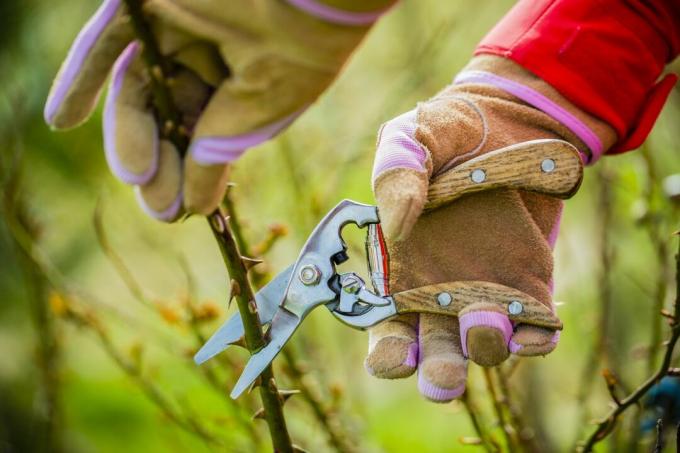
Avoid frost damage to plants
Here's what you can do to protect your plants from frost damage:
Choose native, hardy species and varieties: Avoiding frost damage begins with the choice of plants.
Only buy hardy outdoor plants: These can be found in good perennial nurseries or tree nurseries. Plants that are not hardened are not hardy and must be protected over the winter.
Customize your care: Organic fertilization in autumn, which tends to focus on potassium and does not supply too much nitrogen, promotes the frost resistance of many plants. In autumn, you should avoid heavy watering, fertilizing and cutting plants.

Hibernate potted plants correctly: At the Overwintering of potted plants you should pay attention to the individual temperature and light requirements of the different plants. Also insulate the pots of plants that will stay outside over the winter.
Protect bedding plants from frost: This can be done, for example, with an insulating mulch layer made of straw, leaves or ours Plantura organic pine bark. It consists of 100% softwood bark and is sustainably produced in Europe.
Apply a white coat to young trees: This makes frost cracks in the bark less likely, because the bark does not heat up as quickly due to the white color. This reduces the tension between the cold heartwood and the warmer bark.
Tip: Frost damage to hemp palms can be avoided thanks to a few tips Hibernation of hemp palms easily avoided. And everything you need to know about Overwintering your olive tree can be found in a separate article. Even on roses (pink) and climbing roses, frost damage can occur. To prevent this, see our article on Overwintering roses suggestions.
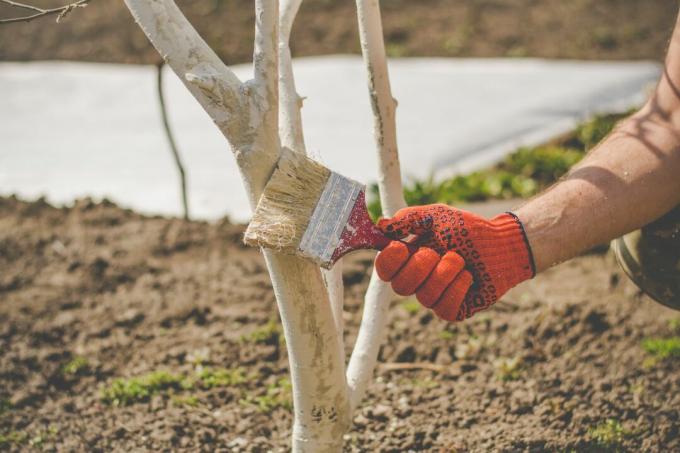
But winter doesn't just bring death and cold to your garden. Plants that bloom in winter provide joy and splashes of color during this time. So we have one Overview of the most beautiful winter bloomers compiled for you.



